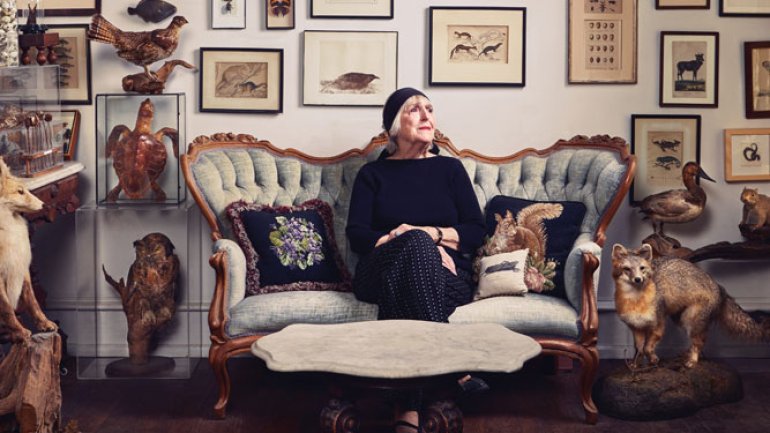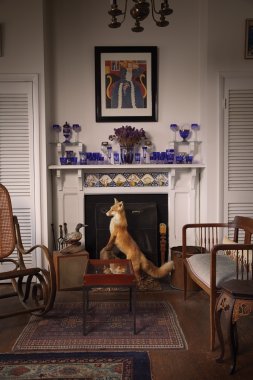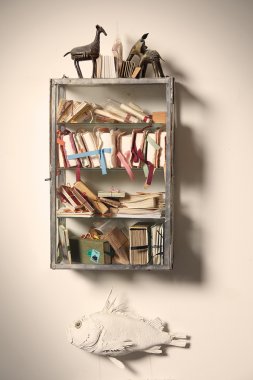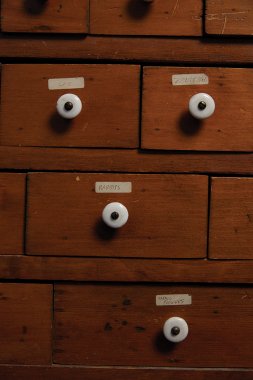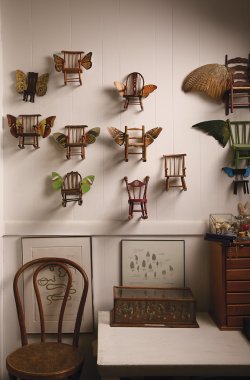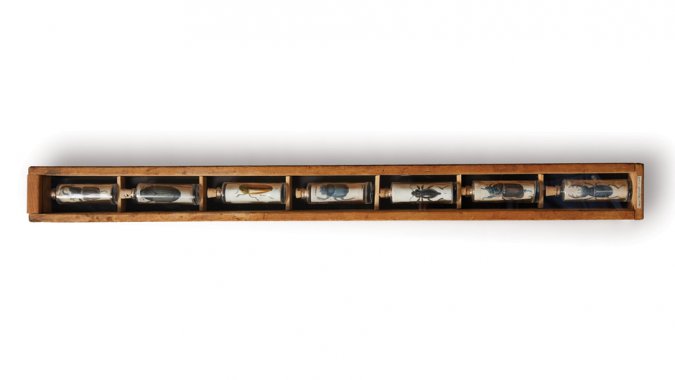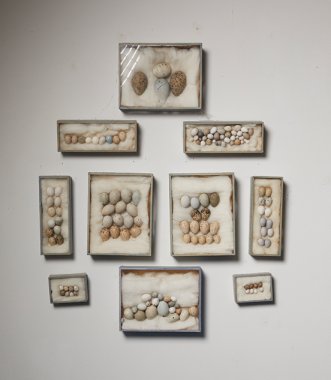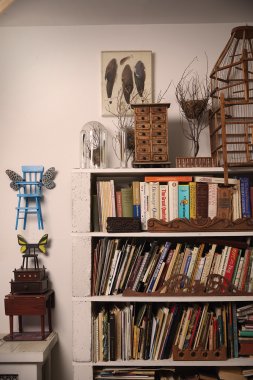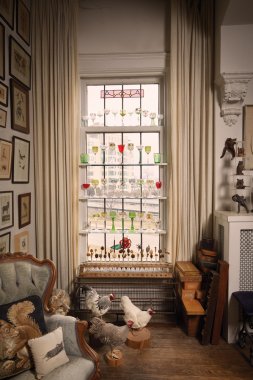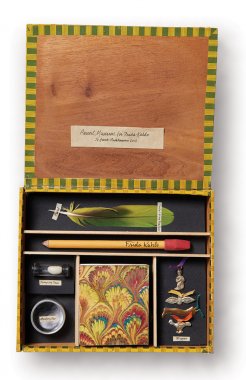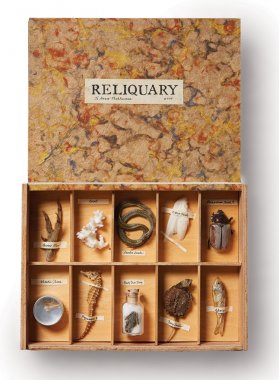Wildlife Preserve
Wildlife Preserve
Joanna Poehlmann is known for her meticulously rendered, often witty tributes to nature and the works of old masters, so it should be no surprise that her home is brimming with both. Up a narrow flight of stairs in an apartment carved from a Gothic Victorian, she has built a space where artifacts and art books are easily at hand, where she can spend time with her own work before letting it leave home.
Poehlmann has traveled the world but happily remains in Milwaukee, the city of her birth. Her apartment, with views of Lake Michigan, is an easy walking distance from the Milwaukee Art Museum.
At 86, she creates daily and can’t imagine running out of ideas. Her studio is separated from her living room by a lofty hallway that’s a timeline of a long creative career, hung with shadow boxes, collages, drawings, prints, and watercolors. She adds new items often.
Elsewhere in the apartment are artworks, specimens, and artifacts that speak to her love of animal life and the natural world. Prints and drawings of bugs, birds, and other wild things fill a wall of her living room. The taxidermist’s art is represented, too; stuffed animals lend a wild but friendly presence to the rooms and serve as willing models when called upon.
Poehlmann’s world is a tactile, deeply observed one, and her domestic surroundings reinforce this at every turn.
You’re working almost exclusively on your “small museums” right now – boxes you’ve rebuilt and filled with artifacts. They seem to incorporate bits and pieces of everything you’re interested in.
If I ever have a show of them, it’ll be called “Thinking Inside the Box.” They’re “cabinets of curiosity” that I’ve been working on, and they finally end up being books in boxes, too. I give homage to the old masters and nature in my work, so the two kind of blend and complement each other.
Here’s one I can’t even move because I haven’t glued everything in yet. It’s an homage to Frida Kahlo. There’s a parrot feather because she kept parrots, there’s monkey fur because she had all those monkeys. Here’s a Mexican jumping bean, and some milagros [small charms often used as votive offerings]. She was ill all the time, poor thing. And this is her life [picks up a tiny handmade book with reproductions of Kahlo’s self-portraits]. I found 19 of them, starting way back when she was a teenager, all the way to the year before she died.
It looks like so much fun to fill these boxes.
I’m just having the best time of my life. I didn’t know this was going to happen. I thought I might be out of new ideas as I got older, but I have a bucket list that’s so long it’s just incredible.
Do you use items you already have, or do you have a concept and then go out and hunt?
It works back and forth. Something will inspire me, and I’ll go out and have to find it. Or I’ll have it all in my house at one time. I have all of these books to look through for my homages, books of old masters and stuff. And people bring me things. I’ve been here 50 years, and you just collect so much. Artists are pack rats; we can’t help ourselves. But we use everything.
Fifty years – that’s a long time to nest in one place. What is it about this place that has made it work for you so well?
I think the hall, where I can show my work. And I can walk – I hike 2 miles a day to mass. The grocery store is on the way home. The post office is right there, too, and I use that a lot. I’m near the lake, and you get the bird migrations through. And it has character. They’ve left the building the way it was; I just love it. God wants me to be here for as long as I can climb the stairs and my right-hand keeps working.
How do people react when they come into your house and see all the taxidermy?
Well, if they have children, it’s fun because they want to pet them. And that’s fine; I just let them do that. They think it’s kind of creepy, some of them. Especially the bats. But some of them just think it’s great.
I’ve heard a lot about the birds in your freezer.
Forty-two now.
How do you collect them? Do people give them to you?
I find them on my walks, and yes, people give them to me because they know I draw them. They’re roadkills, or they crash into windows. Of course around here, with all the glass buildings – those tall things, they’re just all over the place – so many birds fly into them. They’re gorgeous buildings, but not for birds. It’s just heartbreaking.
Your domestic and your creative life seem so intertwined. Is that by design, or did it just happen?
It was a perfectly natural thing in all my apartments. Even living at home, I’d drive my parents crazy because I wanted to decorate everything. It’s just part of living with things that inspire you and that you love. All those prints – all of a sudden I had boxes and boxes of them. And when I moved here, I thought: I have these wonderful high walls. So a friend got on a ladder, and I’d tell her which one I wanted where, and she’d do it. It’s been that way for 50 years.
You’re known for your wit and your sense of humor and your lovely plays on words. Where do you think those come from?
Both parents. And I have a brother that was so funny. My dad was great at puns. As for my mother, it was always such a treat to hear her laugh. She had the most wonderful ringing laugh. You knew you really were helping her through a hard day just to make her laugh.
I gave a little talk one time at the Wisconsin Academy of Sciences, Arts & Letters, and I told them that I thought the seventh sense was humor. It appears throughout all of the high arts. Mozart in his operas, some of them are so funny. Ogden Nash’s poetry. Oscar Wilde, the wit there! Shakespeare, oh my goodness. Chaucer! He had me on the floor a couple times. And Don Quixote. If they can do it, why can’t I? I mean, what’s wrong with using humor in the visual arts? Why not lighten the air?
You don’t use a computer and don’t drive a car. What is your advice to people who struggle with closely observing things in today’s distracted world?
I would advise taking walks. A nature break is great for alleviating stress. What can I say? It keeps my mind clear not to have the distraction of technology.
And each piece of art you produce is the result of slowing down to pay attention.
Yes. It takes time. And it’s so pleasurable. It’s such a joy. You see what people don’t see, but you want them to. That’s why you put it down. People think toads are so ugly. I think they’re so beautiful. God worked just as hard on those as he did on a hippopotamus. A little machine is in there, and it’s working, and it’s doing its thing, you know? It’s amazing. Did you know that only 10 percent of our oceans have been explored yet? I wish I lived long enough to see what they’ll find. Off New Zealand they’re finding a thousand [species] a month – new animal life.
More things to draw.
Yes. There you go.
